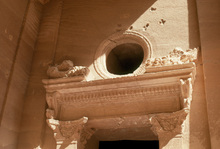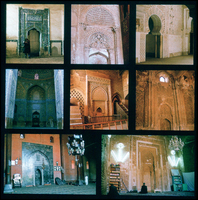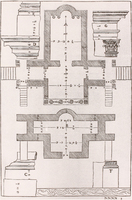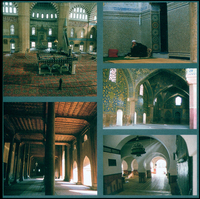| dc.description | The Khaznat was carved into the face of the cliff above al-Siq. Its façade appears to be an example of the linear perspective found in Pompeian wall paintings: its lower order may represent the ground-level of a temple prototype, the stage above representing the side wings of the building, and the circular turret-like structure of the upper order representing a circular shrine between the two wings. The monument was probably a royal tomb, perhaps that of Aretas IV, as indicated both by its location and by its impressive size. The façade is 24.90 m wide, plus an additional 4.70 m in side cutting, and rises to a height of 38.77 m to the top of the urn that crowns its circular tholos or shrine in the centre of the upper order. Six portico columns of the local Nabataeanized Corinthian type (a simplified, blocked out version of the Corinthian capital) stood before the entrance, decorated ornately with floral motifs. The pediment also shows floral decoration, above which two broken pediments are placed, along with the circular shrine. Niches in the lower order contain badly eroded half-round sculpted figures. Approached by a wide flight of steps, a portico opens into the main tomb chamber, with two ornate doorways opening into smaller side chambers. The tomb chamber itself is undecorated, except for the characteristic diagonal dressing found throughout Nabataea, and contains two burial loculi to the "sides, with a third, slightly elevated, on the wall facing the entry.""With the exception of the Khaznet al-Faroun all the so-called royal tombs are located in the necropolis at the foot of the el-Hubta massif. These tombs were so named for their monumental character and in particular because they contained inscriptions which mentioned the name of a Nabatean queen and her epitropos, her plenipotentiary for western affairs of state. Nonetheless, there is no overwhelming evidence that the Nabatean kings were in fact buried there; the tombs may equally have been the last resting place of high-ranking individuals." | en_US |






